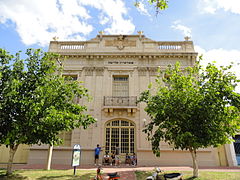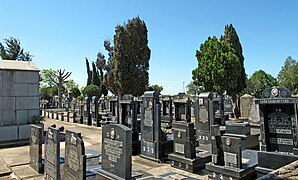Moisés Ville
| Basic data | ||
|---|---|---|
| Surface: | 291 km 2 | |
| location | 30 ° 26 ′ S , 61 ° 17 ′ W | |
| Height above d. M .: | 83 m | |
| Population (2010): | 2425 | |
| Density: | 8.3 inhabitants / km² | |
|
|
||
| administration | ||
| Province : |
|
|
| Department : | San Cristobal | |
| Others | ||
| Postal code : | 2407 | |
| Telephone code: | 03409 | |
Moisés Ville ( Yiddish : מאָזעסוויל) is a municipality in the province of Santa Fe in Argentina , which in 1889 by Jewish refugees from Russia was founded. It is located approx. 177 km from the provincial capital Santa Fe . The place is on the tentative list for the status of UNESCO World Heritage .
history
Moisés Ville was founded on October 23, 1889 by a group of refugees who had fled Russia from pogroms and persecution. From the end of the 19th century, the Jewish Colonization Association (JCA) organized the emigration of Russian Jews abroad, mainly to North and South America . The city of Kiryat Moshe ( City of Moses ) should be named in honor of Maurice de Hirsch , the founder of the JCA . It was first registered as Moïsesville and later Hispanized to Moisés Ville . Moisés Ville was the first Jewish settlement in Argentina. The founding population was made up of families from Podolia (now Ukraine ). In the first half of the 20th century, Moisés Ville developed into a center of Jewish culture known in Argentina and beyond, with several synagogues , cultural and educational institutions and a publication system of national importance in Spanish and Yiddish.
Since the 1950s, both the Jewish population of Moisés Ville and the population as a whole have declined sharply; many younger people emigrated in search of further education and work opportunities. Currently (as of 2015) the place only has a Jewish population of around 10%. Nevertheless, Jewish customs and festivals live on in Moisés Ville, and Yiddish is still spoken there to this day. The Jewish festival calendar is complemented by an annual festival that celebrates the peaceful multicultural coexistence in Argentina. The Moisés Ville Museum keeps documents and objects related to the history of the place.
Historic Buildings
Its history can already be seen in the city map of Moisés Ville, as it is a mixture of the street grid common in the region and the traditional structure of an Eastern European shtetl .
There are three synagogues in Moisés Ville: the splendidly furnished Baron Hirsch Synagogue, built in 1896, the simpler so-called workers synagogue and the Brener Synagogue (Marcus Sterman Synagogue), which has been included in the National Historic Monuments of Argentina . Other important buildings from the time the town was founded are the “Kadima” cultural center, which houses a theater and library, the school and teachers' academy, the Baron Hirsch library and the hospital. The cemetery of Moisés Ville is the oldest Jewish cemetery in Argentina. All of these buildings combine the architecture of Eastern Europe with local building materials and traditions.
literature
- Noe Cociovitch: Genesis de Moisés Ville . 2nd Edition. Milá, Buenos Aires 2005, ISBN 987-9491-55-6 (Yiddish: Mozezviler Bereyshis . Translated by Iaacov Lerman in collaboration with Abraham Platkin, first edition: Los Talleres Graficos de Julio Kaufman, Buenos Aires 1947).
- Adriana Collado, María Elena Del Barco, Eva Guelbert de Rosenthal: Patrimonio urbano arquitectónico de Moisés Ville: inventario de la primera colonia judía en la Argentina . Universidad Nacional del Litoral, Santa Fe 2004, ISBN 987-508-371-2 .
- Michael Giongo: Moisés Ville in Argentina . In: DerStandard.at . November 25, 2012.
- Eva Guelbert de Rosenthal: Memoria oral de Moises Ville. Al rescate de la identidad . Museo Histórico Comunal de Moisés Ville, Buenos Aires 2008, ISBN 978-987-9491-97-3 .
- Judith Laikin Elkin: 150 Years of Solitude: History of the Jews in Latin America . Europäische Verlagsanstalt, Hamburg 1996, ISBN 3-434-50093-6 (English: Jews of the Latin American Republics . Translated by Michael Benthack).
- Simon Romero: Outpost on Pampas Where Jews Once Found Refuge Wilts as They Leave . In: New York Times . June 9, 2013.
- Comisión del Centenario de la Colonización Judía en la Argentina y Fundación de Moisés Ville (ed.): Moisés Ville: 1889-1989 . Buenos Aires 1989.
Web links
- Moisés Ville on the UNESCO World Heritage Center website for tentative lists.
- Moisés Ville on the Santa Fe Provincial Government website (Spanish).
- Historical Museum of Moisés Ville (Spanish).








